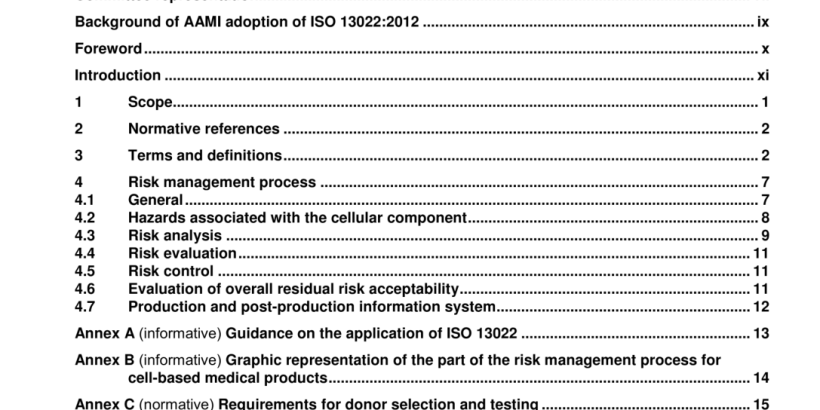ANSI AAMI ISO 13022-2012 pdf download
ANSI AAMI ISO 13022-2012 pdf download.Medical products containing viable human cells – Application of risk management and requirements for processing practices
1 Scope
This International Standard specifies requirements and guidance for processing practices and managing risk associated with viable cellular components of products regulated as medicinal products, biologics, medical devices and active implantable medical devices, or combinations thereof. It covers viable human materials of autologous as well as allogeneic human origin, obtained from living or deceased donors. For manufacturers of medical products containing viable cells of human origin, this International Standard specifies procedures to be used in processing and handling, as well as those to be used in identifying the hazards and hazardous situations associated with such cells, in order to estimate and evaluate the resulting risks, to control these risks, and to monitor the effectiveness of that control. Furthermore, this International Standard outlines the decision process for the residual risk acceptability, taking into account the balance of residual risk and expected medical benefit as compared to available alternatives. This International Standard provides requirements and guidance on risk management related to the hazards typical of medical products manufactured utilizing viable human materials, such as:
a) contamination by bacteria, molds, yeasts or parasites;
b) contamination by viruses;
c) contamination by agents causing Transmissible Spongiform Encephalopathies (TSE);
d) contaminating material responsible for undesired pyrogenic, immunological or toxicological reactions;
e) decomposition of the product and degradation products caused by inadequate handling;
f) hazards related to the tumorigenic potential of the cell types used;
g) complications resulting from unintended physiological and anatomical consequences (this includes unintended migration of cells, unwanted release of biologically active substances such as hormones and cytokines, and unintended interactions between cellular and non-cellular components of the product);
h) failure of traceability;
i) complications resulting from the material eliciting an unintended immunogenic reaction.
For the evaluation of contamination with other unclassified pathogenic entities, similar principles might be applicable.
Risk management is of particular importance to the cellular component of medical products including viable human cells or tissues because of the inherent hazards of this group of products and the variety of stakeholders, including medical practitioners, organizations providing health care, governments, industry, patients and members of the public. Additionally, these stakeholders might be affected by the availability of this type of medical product (the cellular component of a medical product is of particular importance because this raw material can be more rare than other components of a medical product). Therefore lack of availability for the patient is to be considered. The manufacturer shall make judgments relating to the safety of a cell-based medical product, including the acceptability of risks, taking into consideration the generally accepted state of the art, to determine the suitability of a medical product to be placed on the market for its intended use. T his International Standard specifies a process through which the manufacturer of a cell-based medical product can identify hazards associated with the cellular component of the product, estimate and evaluate the risks associated with these hazards, control these risks, and monitor the effectiveness of that control. The manufacturer shall justify the use of human material (including the choice and source of cell type and/or tissues) based on the residual risk acceptability, considering the balance of residual risk and expected medical benefit, as compared to available alternatives. When considering the risks and benefits of the product, the impact of the surgical procedure required for its administration is to be considered.
